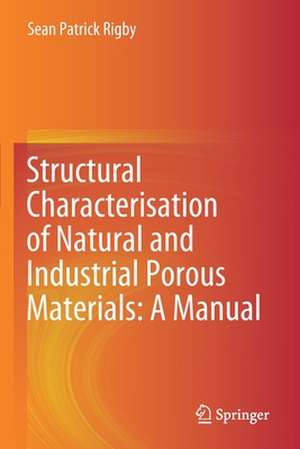Structural Characterisation of Natural and Industrial Porous Materials: A Manual
Autor Sean Patrick Rigbyen Limba Engleză Paperback – 16 mai 2021
Featuring examples taken from case studies of real-world industrial materials, this book is intended for industrial practitioners and researchers. It provides a manual of potential techniques and answers questions concerning porous materials that arise in areas such as the catalyst industry, the oil and gas sector, batteries, fuel cells, tissue engineering scaffolds and drug delivery devices.
| Toate formatele și edițiile | Preț | Express |
|---|---|---|
| Paperback (1) | 636.45 lei 6-8 săpt. | |
| Springer International Publishing – 16 mai 2021 | 636.45 lei 6-8 săpt. | |
| Hardback (1) | 892.28 lei 6-8 săpt. | |
| Springer International Publishing – 16 mai 2020 | 892.28 lei 6-8 săpt. |
Preț: 636.45 lei
Preț vechi: 748.76 lei
-15% Nou
Puncte Express: 955
Preț estimativ în valută:
121.79€ • 127.41$ • 101.17£
121.79€ • 127.41$ • 101.17£
Carte tipărită la comandă
Livrare economică 03-17 aprilie
Preluare comenzi: 021 569.72.76
Specificații
ISBN-13: 9783030474201
ISBN-10: 3030474208
Ilustrații: X, 203 p. 95 illus., 39 illus. in color.
Dimensiuni: 155 x 235 mm
Greutate: 0.31 kg
Ediția:1st ed. 2020
Editura: Springer International Publishing
Colecția Springer
Locul publicării:Cham, Switzerland
ISBN-10: 3030474208
Ilustrații: X, 203 p. 95 illus., 39 illus. in color.
Dimensiuni: 155 x 235 mm
Greutate: 0.31 kg
Ediția:1st ed. 2020
Editura: Springer International Publishing
Colecția Springer
Locul publicării:Cham, Switzerland
Cuprins
Chapter 1 - Introduction.- Chapter 2 - Gas sorption.- Chapter 3 - Mercury porosimetry.- Chapter 4 - Thermoporometry and Scattering.- Chapter 5 - NMR and microscopy methods.- Chapter 6 - Hybrid methods.- Chapter 7 - Structural characterisation in absorbent and catalyst design.- Chapter 8 - Structural characte risation in engineering geology.
Notă biografică
Dr. Sean Patrick Rigby completed his Ph.D. at the University of Cambridge. He then worked as a Product Research Manager and Process Engineer for ICI Synetix (formerly Katalco) for four years, where he developed new adsorbents and managed the Catalyst Characterisation laboratory. Dr Rigby then moved to the University of Bath, UK, where he worked as an academic for ten years, before moving to the University of Nottingham, where he is currently Professor of Chemical Engineering and Director of the GeoEnergy Research Centre. Dr. Rigby is a Fellow of the IChemE and Chartered Engineer, a Fellow of the Geological Society, and Fellow of IUPAC.
Textul de pe ultima copertă
This book focuses on structural characterisation techniques for porous materials. Covering a range of techniques, including gas sorption, mercury porosimetry, thermoporometry, NMR and imaging methods, this practical guide presents the basic theory behind each characterisation technique, and discusses the practicalities of the experimental and data analysis approaches needed for complex industrial samples.
The book shows readers how to approach characterising a particular sort of material for the first time and then how to develop a strategy for more in-depth analysis. It also demonstrates how to determine the best techniques for solving particular problems, and describes methods of obtaining the required information, as well as the limitations of various methods. It particularly highlights a scientific approach involving parameter validation and simple acquisition.
Featuring examples taken from case studies of real-world industrial materials, this book is intended for industrial practitioners and researchers. It provides a manual of potential techniques and answers questions concerning porous materials that arise in areas such as the catalyst industry, the oil and gas sector, batteries, fuel cells, tissue engineering scaffolds and drug delivery devices.
Featuring examples taken from case studies of real-world industrial materials, this book is intended for industrial practitioners and researchers. It provides a manual of potential techniques and answers questions concerning porous materials that arise in areas such as the catalyst industry, the oil and gas sector, batteries, fuel cells, tissue engineering scaffolds and drug delivery devices.
Caracteristici
Provides a practical guide to structural characterisation techniques for industry practitioners Describes various techniques for pore structural characterisation of porous solids Explains the benefits of hybridisation approaches
